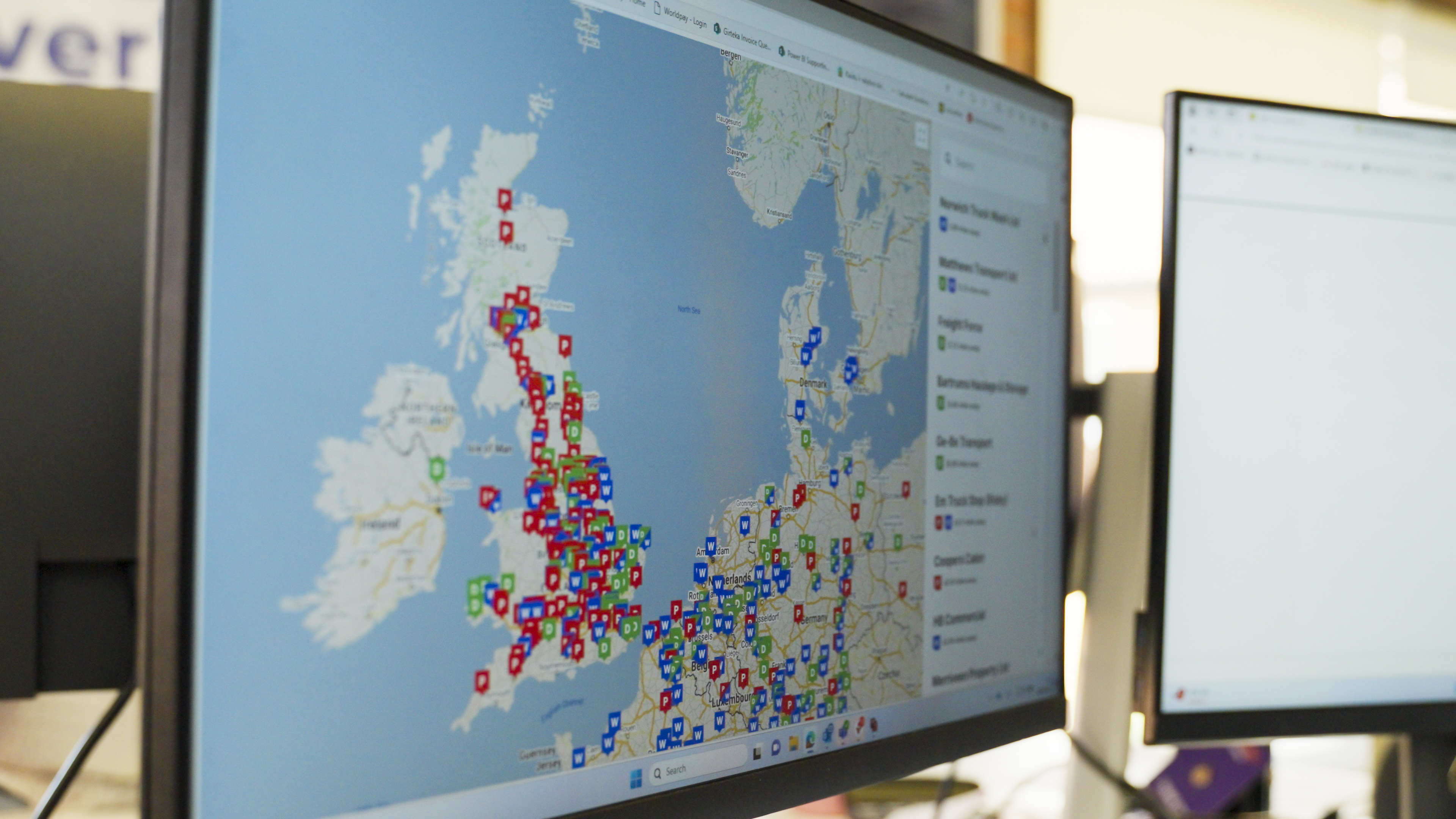
Miranda Blake
Паливні картки в транспорті - як SNAP спрощує життя автопарку
Створено: 20.11.2024
•
Оновлено: 20.11.2024
Потреба в ефективних рішеннях для управління автопарком (https://snapacc.com/fleet-operators/) ще ніколи не була такою гострою. SNAP Account - це потужна альтернатива традиційним паливним карткам, що забезпечує комплексну, зручну платформу, яка спрощує платежі та підвищує операційну ефективність. Вирішуючи такі ключові проблеми, як контроль витрат, адміністративний тягар та задоволеність водіїв, ми прокладаємо шлях до нової ери в управлінні автопарком.
Комплексне платіжне рішення
[SNAP Account] (https://snapacc.com/) - це універсальне рішення для оплати послуг автопарку, яке революціонізує спосіб оплати різних витрат водіями. Використовуючи лише номерний знак автомобіля, вони можуть оплачувати цілий ряд послуг, включаючи:
Паркування: Доступ до понад 380 спеціальних стоянок для вантажівок по всій Європі гарантує, що вони завжди матимуть безпечне та надійне місце для відпочинку. * Мийки:* З більш ніж 230 доступними мийками підтримувати чистоту транспортних засобів у належному стані не складе жодних труднощів. * Пальне:* Водії можуть заправлятися на партнерських станціях, що спрощує роботу. * Плата за проїзд через Дартфорд:** Автоматизовані платежі за проїзд позбавляють вас необхідності мати при собі готівку.
Ми значно зменшуємо тягар носіння декількох карток або готівки, оскільки наше програмне забезпечення консолідує ці різні платежі в єдину систему.
Спрощене адміністрування
Для керівників автопарків завдання, пов'язані з паливними картками, можуть бути непосильними. На щастя, SNAP Account спрощує ці процеси кількома способами:
- Єдиний рахунок-фактура:** Всі транзакції зводяться в один рахунок-фактуру, що значно скорочує паперовий документообіг та адміністративні витрати.
- Автоматизоване ведення обліку:** Ця функція спрощує податкову звітність та управління фінансами, заощаджуючи дорогоцінний час.
- Керування транспортними засобами:** Ви можете додавати стільки транспортних засобів, скільки потрібно, і групувати їх за типом або призначенням.
Така автоматизація та централізація гарантує, що менеджери автопарку можуть зосередитися на стратегічних рішеннях, а не загрузнути в паперовій тяганині.
Покращений контроль витрат
Обліковий запис SNAP пропонує потужні інструменти для оптимізації витрат:
- Ліміти витрат:** Менеджери автопарків можуть встановлювати обмеження та санкціонувати покупки, гарантуючи, що витрати не виходять за рамки бюджету.
- Знижки:** Ексклюзивні ціни на АЗС нашого партнера Certas Energy дозволяють значно заощадити.
- Нульова плата за встановлення:** На відміну від традиційних систем паливних карток, початкова плата за встановлення або підписку відсутня, що полегшує початок роботи.
- Відсутність прихованих платежів:** Ми усуваємо надбавки, які зазвичай накладають компанії, що випускають паливні картки, за послуги на заправках для вантажівок, забезпечуючи прозорість у ціноутворенні.
Ці функції дозволяють компаніям ефективно управляти своїми витратами на паливо та обслуговування, що призводить до підвищення прибутковості.
Зацікавлені в тому, як інші отримують вигоду від SNAP? [Читайте наш кейс] (https://snapacc.com/newsroom/efficiency-on-the-road-how-delintra-sp-zoo-are-optimising-their-fleet-with-snap/).

Переваги для водіїв
Обліковий запис SNAP розроблений з думкою про водія, пропонуючи численні переваги, які покращують його досвід на дорозі:
- Спрощені платежі: Забудьте про жонглювання кількома картками або готівкою. Простота використання лише номерного знаку транспортного засобу для здійснення транзакцій змінює правила гри.
- Розгалужена мережа:** Маючи доступ до понад 600 сервісних партнерів по всій Європі, клієнти можуть легко знайти потрібні їм послуги.
- Можливість попереднього бронювання:** Додаток intruck дозволяє легко бронювати місця для паркування вантажівок, гарантуючи, що водії можуть заздалегідь зарезервувати їх заздалегідь.
Спрощуючи життя на дорозі, ми підвищуємо ефективність автопарку та рівень задоволеності водіїв, що робить нас кращим вибором для багатьох операторів.
Безпека та запобігання шахрайству
У галузі, де безпека має першорядне значення, SNAP Account включає в себе кілька надійних функцій для захисту активів автопарку:
- Зареєстровані номерні знаки:** Кожна транзакція базується на зареєстрованому номерному знаку, що гарантує, що платежі можуть здійснювати лише уповноважений персонал та транспортні засоби.
- Контроль витрат:** Менеджери можуть встановлювати ліміти, зменшуючи ризик зловживань.
- Безпечне паркування:** Багато партнерських пунктів пропонують посилені функції безпеки, що гарантує спокій водіям.
Ці заходи разом створюють безпечне середовище для роботи автопарку, захищаючи як транспортні засоби, так і фінанси.
Еволюція паливних карток
Паливні картки були наріжним каменем управління автопарком протягом багатьох років, але традиційні паливні картки часто супроводжуються прихованими платежами, обмеженими можливостями обслуговування та громіздкими адміністративними процесами. На відміну від них, [SNAP Fuel] (https://snapacc.com/snap-fuel/) усуває ці недоліки, пропонуючи сучасне комплексне рішення, яке відповідає вимогам сучасного управління автопарком.
Основні відмінності між SNAP та стандартними паливними картками

Відгуки клієнтів
Хочете дізнатися, як інші користуються перевагами облікового запису SNAP? Ось що говорять деякі оператори автопарків:
- Фенвік Хаулэйдж: "SNAP трансформував нашу діяльність. Більше немає клопоту з квитанціями; наші водії просто використовують свою реєстрацію. Це змінює правила гри".
- L Cunningham & Daughter Haulage: "Гнучкість, яку надає SNAP, була безцінною. Наші водії можуть паркуватися, не турбуючись про авансові платежі, а виставлення рахунків відбувається без проблем". Wincanton: "Простота використання не має собі рівних. Наші водії можуть бронювати місця для паркування та сплачувати без готівки чи карток, що значно спрощує їхню роботу".
- Джек Річардс: "SNAP підвищив нашу ефективність та значно зменшив витрати. Це важливий інструмент для нашого автопарку".
Якщо ви хочете отримати вигоду від експлуатації власного автопарку, зв'яжіться з нами за телефоном +44 (0)1603 777242.



